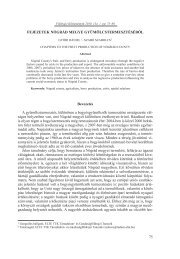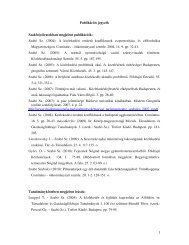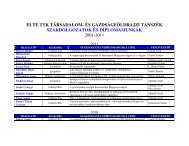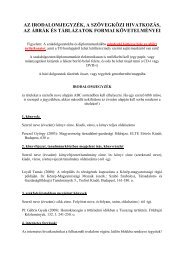ä¸å½ä¸ä¸ä¸æ¬§åºé ä¸åºåå åå±å·®è·çå¨ææ¼åâ
ä¸å½ä¸ä¸ä¸æ¬§åºé ä¸åºåå åå±å·®è·çå¨ææ¼åâ
ä¸å½ä¸ä¸ä¸æ¬§åºé ä¸åºåå åå±å·®è·çå¨ææ¼åâ
You also want an ePaper? Increase the reach of your titles
YUMPU automatically turns print PDFs into web optimized ePapers that Google loves.
Lee, S.S. (2004): Spatial Dynamic Variations of Regional Inequality in Korea and Japan. Studies in Regional<br />
Science 34/1. pp. 97–116.<br />
Lőcsei, H. (2004): A foglalkoztatás ágazati és regionális dimenzióinak kapcsolata az ezredvégi Magyarországon.<br />
[The relationship of structural and regional dimensions of employment in Hungary at the millenium] In: Nemes<br />
Nagy, J. (ed.): Térségi és települési növekedési pályák Magyarországon. [Regional and settlement-level growth<br />
lines in Hungary] RTT 9. Eötvös Loránd University, Department of Regional Geography. Budapest. pp. 43–58.<br />
Lőcsei, H. (2009): A válság földrajza – nyertesekből vesztesek. [The geography of the crisis – winners becoming<br />
losers] Világgazdaság [World Economy] 15.04.2009<br />
Nemes Nagy, J. (1987): A regionális gazdasági fejlődés összehasonlító vizsgálata. [A comparative analysis of<br />
regional economic development] Akadémiai Press. Budapest<br />
Nemes Nagy, J. (1993): Adalékok a térbeliség társadalmi magyarázóerejéhez. [Additions to the social explaining<br />
force of spatiality] In: Enyedi Gy. (ed.): Társadalmi-területi egyenlőtlenségek Magyarországon. [Social-spatial<br />
disparities in Hungary] KJK. Budapest. pp. 23–37.<br />
Nemes Nagy, J. (2005): Fordulatra várva – a regionális egyenlőtlenségek hullámai. [Waiting for a turn – the<br />
waves of regional disparities] In: Dövényi Z.–Schweizer F. (eds.): A földrajz dimenziói. [Dimensions of<br />
Geography] Geographical Research Institute, Hungarian Academy of Sciences. Budapest. pp. 141–158.<br />
http://geogr.elte.hu/ref/pdf/nnj-hullamok.pdf<br />
Nemes Nagy, J. (2009): Terek, helyek, régiók. A regionális tudomány alapjai. [Spaces, places, regions.<br />
Fundaments of regional science] Akadémiai Press, Budapest<br />
Nemes Nagy, J.–Kullmann, Á.–Fekete, A.–Szabó, P. (2000): A területi fejlődés „állami” és „piaci” útjai az<br />
1990-es években. [„State‖ and „market‖ ways of regional development during the 1990s] Területi Statisztika<br />
[Regional Statistics] 3. pp. 203–220.<br />
Rawski, T.G. (2001): What is Happening to China’s GDP Statistics China Economic Review 12/4, pp. 298–302.<br />
Rostow, W.W. (1960): The stages of economic growth: A non-communist manifesto. Cambridge University Press.<br />
Cambridge (Massachusetts)<br />
Szabó, P. (2008): A gazdasági fejlettség egyenlőtlensége az Európai Unió különböző területi szintjein. [Inequality<br />
of economic development at different spatial levels of the European Union] Területi Statisztika [Regional<br />
Statistics] 11/6., pp. 687–699.<br />
Timár, J.–Barta, Gy.–G Fekete, É.–Kukorelli SzörényinéI. (2005): Politics, Society and Economy in Space:<br />
Spatial Processes in the Era of Transition in Hungary. In: Timár, J.–Barta, Gy.–G Fekete, É.–Kukorelli<br />
Szörényiné I. (eds.): Hungarian Spaces and Places – Patterns of Transition. Centre for Regional Studies,<br />
Hungarian Academy of Sciences. Pécs. pp. 1–16.<br />
Westlund, H. (2000): The Soviet paradox: imbalanced equalisation and balanced divergency. In: Westlund,<br />
H.–Granberg, A.–Snickars, F. (eds.): Regional Development in Russia. Past Policies and Future Prospects.<br />
Edward Elgar Publishing. Cheltenham–Northampton. pp. 1–36.<br />
Williamson, J.G. (1965): Regional inequality and the process of national development: a description of the<br />
patterns. Economic Development and Cultural Change 13/4., Part II., pp. 3–84.<br />
数 据 资 料<br />
EUROSTAT Regio database.<br />
http://epp.eurostat.ec.europa.eu/portal/page/portal/statistics/themes<br />
University of Michigan: All China Data Center. http://chinadataonline.org/<br />
22









